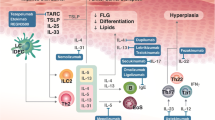Abstract
Clinical guidelines relating to atopic dermatitis, systemic beta-blockade for infantile hemangiomas and acne have all been published within the last 2 years. Important studies have also better characterized emerging infections such as coxsackievirus a6, mycosis fungoides, severe cutaneous drug reactions in the pediatric population, and hidradenitis suppurativa; these will all be reviewed here.
Similar content being viewed by others
References
Eichenfield LE, Tom WT, Chamlin S, et al. Guidelines atopic dermatitis. J Am Acad Dermatol. 2014;70(2):338–51.
Ring J, Alomar A, Bieber T, et al. Guidelines for treatment of atopic eczema (atopic dermatitis) part I. J Eur Acad Dermatol Venereol. 2012;26(8):1045–60.
Ring J, Alomar A, Deleuran M, et al. Guidelines for treatment of atopic eczema (atopic dermatitis) part II. J Eur Acad Dermatol Venereol. 2012;26(9):1176–93.
Tennis P, Gelfand JM, Rothman KJ. Evaluation of cancer risk related to atopic dermatitis and use of topical calcineurin inhibitors. Br J Dermatol. 2011;165(3):465–73.
Leaute-Labreze C, Dumas de la Rogue E, Hubiche T, et al. Propranolol for severe hemangiomas of infancy. N Engl J Med. 2008;358(24):2649–51.
Lou Y, Peng WJ, Cao Y, et al. The effectiveness of propranolol in treating infantile hemangiomas: a meta-analysis including 35 studies. Br J Clin Pharmacol. 2014;78(1):44–57.
Drolet BA, Frommelt PC, Chamlin SL, et al. Initiation and use of propranolol for infantile hemangioma: report of a consensus conference. Pediatrics. 2013;131(1):128–40.
Eichenfield LF, Krakowski AC, Piggott C, et al. Evidence-based recommendations for the diagnosis and treatment of pediatric acne. Pediatrics. 2013;131:163–86.
Lam J, Pope E. Pediatric pityriasis lichenoides and cutaneous T cell lymphoma. Curr Op in Pediatr. 2007;19:441–5.
Weinstock MA, Reynes JF. The changing survival of patients with mycosis fungoides: a population-based assessment of trends in the United States. Cancer. 1999;85:208–11.
Weinstock MA, Gardstein B. Twenty-year trends in the reported incidence of mycosis fungoides and associated mortality. Am J Public Health. 1999;89:1240–4.
Slater D. The new world health organization-european organization for research and treatment of cancer classification for cutaneous lymphomas: a practical marriage of two giants. Br J Dermatol. 2005;153:874–80.
Fink-Puches R, Chott A, Ardigo M, et al. The spectrum of cutaneous lymphomas in patients less than 20 years of age. Pediatr Dermatol. 2004;21:525–33.
Boos M et al. PL and MF: an update on the diagnosis of the most benign and malignant lymphoproliferative disorders in childhood. Curr Ped Rep 2013, Springer
Hodak E, Amitay-Laish I, Feinmesser M, et al. Juvenile mycosis fungoides: cutaneous T-cell lymphoma with frequent follicular involvement. J Am Acad Dermatol. 2014;70:993–1001.
Laws PM, Shear NH, Pope E. Childhood Mycosis Fungoides: experience of 28 patients and response to phototherapy. Peds Derm. 2014: 1–6.
Atanaskovic-Markovic M, Medjo B, Gavrovic-Jankulovic M, Cirkovic Velvckovic T, Nikolic D, Nestorovic B. Stevens-Johnson syndrome and toxic epidermal necrolysis in children. Pediatr Allergy Immunol. 2013;24(7):645–9.
Finkelstein Y, Macdonald EM, Li P, Hutson JR, Juurlink DN. Recurrence and mortality following severe cutaneous adverse reactions. JAMA. 2014;311(21):2231–2.
Wong S, Koh M. PD33-drug reaction and eosinophilia with systemic symptoms (DRESS): a 10-year review in a pediatric population. Clin and Transl Allergy. 2014;4 Suppl 1:33.
Chong K, Chan D, Cheung Y, Ching L, Hie S, Thomas T, et al. Association of carbamazepine-induced severe cutaneous drug reactions and HLA-B* 1502 allele status, and dose and treatment duration in paediatric neurology patients in Singapore. Arch Dis Child. 2014;99:581–4.
Amstutz U, Shear N, Rieder M, Hwang S, Fung V, Nakamura H, et al. Recommendations for HLA-B* 15: 02 and HLA-A* 31: 01 genetic testing to reduce the risk of carbamazepine-induced hypersensitivity reactions. Epilepsia. 2014;55(4):496–506.
MMWR Morb Mort Weekly Rep Notes from the field: Severe hand foot and mouth disease associated with coxsackie A6 Alabama, Connecticut, California, Nevada November 2011-February 2012. 2012 Mar 30;61(12):213–4.
Mathes EF, Oza V, Frieden IJ, et al. Eczema coxsackium and unusual cutaneous findings in an enterovirus outbreak. Pediatrics. 2013;132:e149–57.
Gold DA, Reeder VJ, Mahan M, et al. The prevalence of metabolic syndrome in patients with hidradenitis suppurativa. J Am Acad Dermatol. 2014;70(4):699–703.
Machet L, Samimi M, Delage M, et al. Systematic review of the efficacy and adverse events associated with infliximab treatment of HS in patients with co-existent inflammatory diseases. J Am Acad Dermaol. 2013;69(4):649–50.
Randhawa HK et al. Finasteride for the treatment of hidradenitis suppurativa in children and adolescents. JAMA Derm. 2013;149(6):732–5.
Zarchi K et al. Successful treatment of severe hidradenitis suppurativa with anakinra. JAMA Derm. 2013;149(10):1192–4.
Compliance with Ethics Guidelines
Conflict of Interest
K Khorsand and S Backus both declare no conflicts of interest.
R Sidbury has served as an investigator and on an Advisory Board for Pierre Fabre Dermatology; on an Advisory Board for Quinnova Pharmaceutical; on an Advisory Board for Galderma Pharmaceutical called the Early Intervention Acne Council; and as an expert witness for Roche Pharmaceutical.
Human and Animal Rights and Informed Consent
This article does not contain any studies with human or animal subjects performed by any of the authors.
Author information
Authors and Affiliations
Corresponding author
Rights and permissions
About this article
Cite this article
Khorsand, K., Backus, S. & Sidbury, R. What’s New in Pediatric Dermatology. Curr Derm Rep 3, 187–190 (2014). https://doi.org/10.1007/s13671-014-0091-0
Published:
Issue Date:
DOI: https://doi.org/10.1007/s13671-014-0091-0




